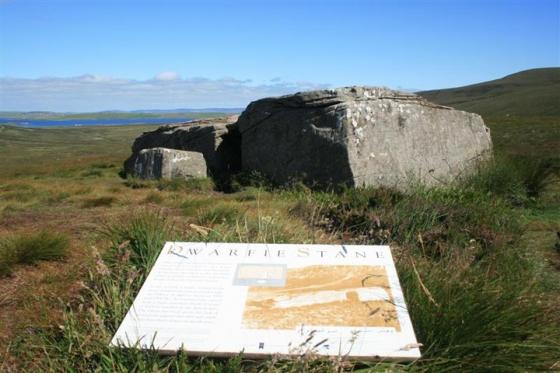As you go down towards Gyre you can see Konger’s Knowe on the left a couple of field’s away from the road, so I decided to try a direct approach first. Unfortunately the old field dyke boundary is a formidable obstacle still, broad and deep and mired in vegetation, so I had to content myself with standing on top of the almost buried wall this side of the dyke. On trying to find a way further down I thought I was in luck when I saw two tall stones across the dyke, but though I thought there were other materials there I could not see through the plants. [Only after I came back did I realise that this was the old gate in the boundary referred to by Johnston (HY34440489) else I would certainly have taken preliminary photos and measurements. I had not expected an actual physical entity surviving to now. Think of a farm gate using middling {1.1m}standing stones for posts only with a seperation{1.3m} nearer to that of a domestic garden gate. Quite the thing. I shall have to go back next year when the entire site is rather more visible !]. Kongar is either named for being a ’ king’s farm’ or after someone of that name lost to history.
After visiting the ‘chambered cinerary urns’ site above Gyre I went back up the road and entered the quarry field (used for building the slab fences hereabouts in the early to mid-19th century) and from the opposite corner (whose ‘Orkney gate’ was thankfully down) walked across into the Kongarsknowe field. At present there is a large circular pool of water by the lower half of the turf-covered mound, probably in a natural depression. What was most necessary was to find out the knowe’s composition. Even from afar I had seen exposed bits. Looked like the usual earth with a few small stones. Only up real close did this reveal itself to be mostly ?decayed rock, probably sandstone. Though Johnston called this a tumulus there appeared to be no signs of structure. On the other hand I cannot believe this to be a (wholly) natural mound. Unable to tell its shape and there was too much wind for the tape measure. It paced out to about 70m around the steeper, unploughed, main bit. From here the mound slopes more gradually until it peters out somewhat over 90m circumference. The central portion (? rocky core) is well over two meters high (possibly three) and the ‘base’ another metre below that.









































































































































































